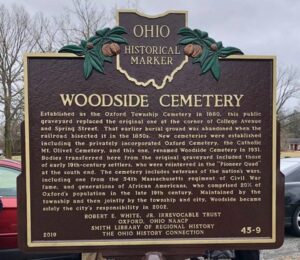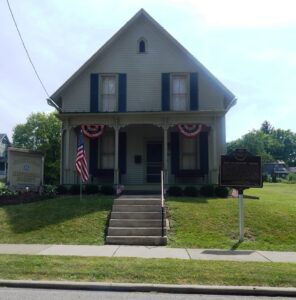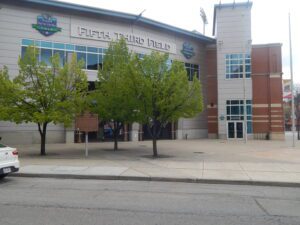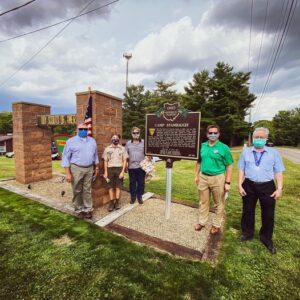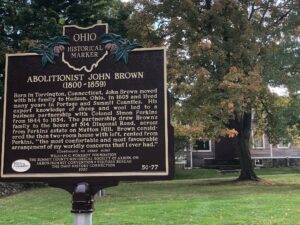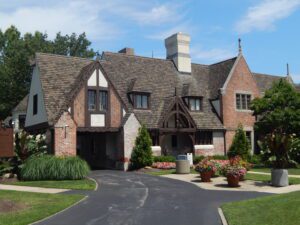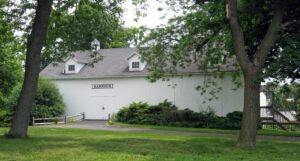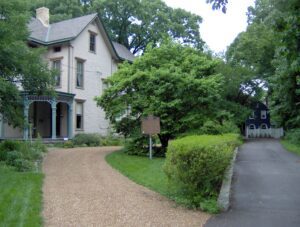, OH
Established as the Oxford Township Cemetery in 1880, this public graveyard replaced the original one at the corner of College Avenue and Spring Street. That earlier burial ground was abandoned when the railroad bisected it in the 1850s. New cemeteries were established including the privately incorporated Oxford Cemetery, the Catholic Mt. Olivet Cemetery, and this one, renamed Woodside Cemetery in 1931. Bodies transferred here from the original graveyard included those of early 19th-century settlers, who were reinterred in the “Pioneer Quad” at the south end. The cemetery includes veterans of the nation’s wars, including one from the 54th Massachusetts regiment of Civil War fame, and generations of African Americans, who comprised 20% of Oxford’s population in the late 19th century. Maintained by the township and then jointly by the township and city, Woodside became solely the city’s responsibility in 2002.
, OH
Alexander Frankfort (1842-1930), the last surviving Civil War veteran from Struthers, built this house in 1884. His wife, Louisa Jane Johns Frankfort (1851-1921), purchased the land from Thomas Struthers for $190.00. The house is of balloon frame construction and has sandstone foundation. The main beam traversing the basement was made from a large tree on the property. Married in 1874, the Frankforts had eight children, but four little ones had died by 1884. The Frankforts brought their fifth child, the infant Alma (1884-1984) to this then new house, where she and three sisters grew up. Alma lived and worked here as a seamstress for 93 years. The house was empty until 1986 when the Mohr family, Alma’s nephews, donated it to the Struthers Historical Society. The historical society renovated the house and opened as a museum in 1989.
, OH
Moses Fleetwood Walker was born on October 7, 1856 in Ohio to Moses M. Walker, a physician, and Caroline, a midwife. He attended and played baseball at Oberlin College and the University of Michigan. In 1883, Walker joined the newly formed Toledo Blue Stockings and became the first African American major league ballplayer when Toledo joined the Major League-sanctioned American Association the following year. As a barehanded catcher, his biggest assets were his catching ability, powerful throwing arm, and aggressive base running. He endured racial prejudice from teammates, opponents, and baseball fans, and eventually left to become a writer, inventor, civil rights advocate, and entrepreneur. Walker was elected to the Ohio Baseball Hall of Fame in 1991. He died in 1924 and is buried in Stuebenville, Ohio in the family plot at Union Cemetery.
, OH
The Boy Scouts of America began in 1910, and by 1912, Scouting was established in the Mahoning Valley. Camp Stambaugh opened in July 1919, thanks to a gift from the estate of prominent local industrialist Henry H. Stambaugh (1858-1919). In his will he had named his friend and business partner Phillip J. Thompson as trustee of Stambaugh’s 86.5 acre Indian Creek Farm. Stambaugh’s expectation was that Thompson would convey the property to the local Scouting organization. In 1919 the property was mostly a treeless pasture and one could see Indian Creek from Stambaugh’s hay barn near Leffingwell Road. That first summer a Council Ring was carved from an old limestone quarry just north of the creek. (Continued on other side)
, OH
Born in Torrington, Connecticut, John Brown moved with his family to Hudson, Ohio, in 1805 and lived many years in Portage and Summit Counties. His expert knowledge of sheep and wool led to a business partnership with Colonel Simon Perkins from 1844 to 1854. The partnership drew Brown’s family to the house at 514 Diagonal Road, across from Perkins’ estate on Mutton Hill. Brown considered the then two-room house with loft, rented from Perkins, “the most comfortable and most favourable arrangement of my worldly concerns that I ever had.” (Continued on other side)
, OH
William E. Telling (1869-1938) was one of ten children born in a farmhouse on this property. As a boy he sold strawberries and milk door-to-door and worked in a local sandstone quarry until at age 23 he purchased a milk route. He and four brothers formed the Telling Brothers Ice Cream Company in 1895 with William as president. A merger in 1915 formed the Telling Belle Vernon Dairy Company that was the first local distributor of pasteurized, glass-bottled milk. Their unique bacteriological laboratory (later Sealtest Laboratories) developed the baby food S.M.A. His recipe for success was “just work and work and work some more; do the work of two and draw the pay of one.”
, OH
The David and Clarissa Harroun family migrated to Sylvania in 1835 and built their home, and in 1858 the barn, on this site. Four generations of this Harroun family called this property home, from 1835-1938. While here, David, Clarissa, and their son Edwin became involved in aiding fugitive slaves across the Underground Railroad to freedom in Canada. David secretly transported the runaways from Maumee to Sylvania in his lumber wagons. The fugitives were covered in hay, and the wagons were driven at night to avoid detection. Once on Harroun’s property, they were hidden in the attic of the home or the hayloft of the barn. The Lathrop family, who lived on a farm to the west, helped the Harrouns by hiding fugitives in the basement of their home. From Sylvania, the runaways were taken to Bedford, Petersburg, or Monroe in Michigan where they were then transported toward Detroit for their crossing into Canada.
, OH
Dr. Winthrop Smith Sterling (1859-1943) founded Mu Phi Epsilon International Professional Music Fraternity on November 13, 1903, at the Metropolitan School of Music in Cincinnati, where he served as dean. The Victorian frame house was built by his parents, Samuel Gano and Eliza Smith Sterling in 1867, and was home to Sterling family members until the early 1940s. A highly respected organist and university teacher, Dr. Sterling taught piano and organ in this home in which he had installed a 12-foot hydraulic pump organ in the “music room.”


